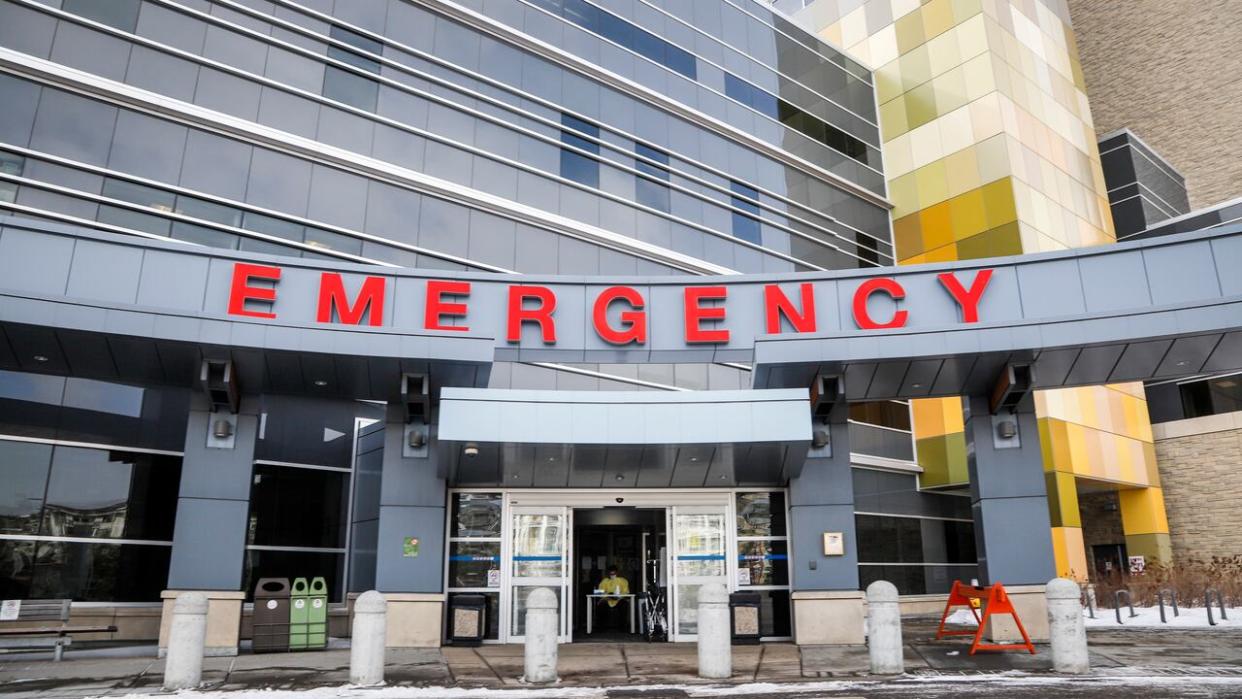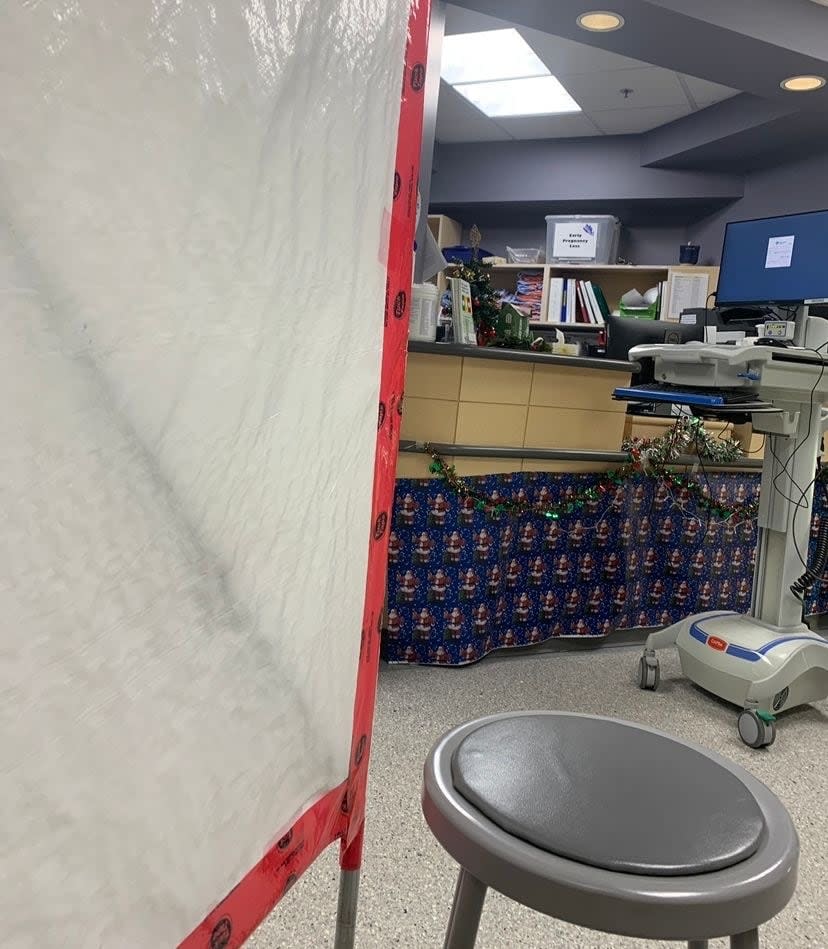Makeshift dividers, hallway medicine are signs of a system in crisis, say Alberta front-line staff

It's been dubbed "hallway medicine" and, more recently, "duct tape medicine" in Alberta.
Doctors and nurses say, whatever you call it, it's a clear sign of a health-care system in distress.
The practice of squeezing patients into non-traditional hospital treatment spaces, or rooms intended for fewer people, is not new but it is increasingly common in this province as hospitals stretch to accommodate ballooning patient numbers, according to front-line staff.
The problem is particularly acute during the respiratory virus season.
In Red Deer, staff are using plastic sheeting secured with duct tape to create makeshift treatment spaces in the ER.
Last week, calling it "duct tape medicine," the Alberta NDP released photos it said were taken on the cardiology unit at the Foothills Medical Centre in November, where temporary walls had been fashioned using white plastic sheeting.
"It's unfortunately become absolutely the norm in our system across Alberta," said Dr. Paul Parks, president of the Alberta Medical Association.
"We've just accepted this normalization of deviant care for so long, that everyone's saying 'Listen, we can't do anymore. We can't give any more.'"
Alberta's emergency rooms are routinely filled with admitted patients who can't be moved to the wards because there are no open beds, forcing doctors and nurses to squeeze in people wherever they can, both on the inpatient units and in ERs.

A photo of the temporary divider made from a white tarp, taken by Jaelene Tweedle on her visit to the Red Deer Hospital's emergency department. (Submitted by Jaelene Tweedle)
Hundreds of overcapacity beds across the province
Alberta's 16 largest hospitals had 423 so-called "overcapacity beds" as of Sept. 30, according to Alberta Health Services (AHS). That doesn't include the extra treatment spaces added in emergency rooms.
In March of 2020, there were 415, but some of those beds have since been absorbed as permanent beds, the health authority noted.
"At any given time, most of those overcapacity spaces are in use. Again, this is not unusual at this time of year," an AHS spokesperson said in an email.
"Sites remain ready to increase capacity as needed, including opening additional temporary surge beds as staffing allows, reconfiguring existing spaces, and maximizing use of virtual hospital capacity."
Parks said front-line staff have been pleading for help.
"My colleagues across the province and across the country are kicking and screaming and saying, 'health-care access has never been as bad as it is right now,'" he said.
According to the United Nurses of Alberta (UNA), hospitals have been running overcapacity for years.
"This is a critical issue," said Danielle Larivee, UNA first vice-president. "Beds in hallways, all over the place. Double [and] triple bunking in all sorts of units where it never should be happening."
And Larivee believes there are safety concerns associated with these practices.
For example, overcapacity spaces may not be equipped with oxygen, suction or proper call bells, she said.
"When you're putting more people in a room than it was designed for then some of those beds don't have access to that. There's legitimate safety issues.… There's none of those processes in hallways," said Larivee.
"It really increases the risk for sure that someone's going to have a very bad outcome that shouldn't have happened."
The executive director of Foothills Medical Centre, Michael Suddes, said there are nearly 70 overcapacity spaces, similar to the one in the photo released by the NDP, at that hospital alone.
"Overcapacity spaces aren't ideal. They're not optimal care spaces. But they are an important part of our overall capacity when we need them when we have temporary increases in demand. So it gets the patient to a care space where they can receive care from the right team," he said, noting the practice helps clear backlogs of admitted patients in the ER.
"We've had to, over this last year or two … increase the number of overcapacity spaces at this hospital and other hospitals, too."

The Alberta NDP released this photo it said was taken by a patient on the cardiology unit at Foothills Medical Centre in November, showing rigid PVC being used to create a temporary divider. AHS said it has 70 such 'overcapacity beds' at Foothills Hospital. (Alberta NDP)
Suddes said the temporary walls made of rigid PVC, such as those as pictured on the cardiology unit, provide more separation and privacy and can reduce illness transmission.
According to AHS, the use of these dividers is not new and regardless of what type of bed a patient is treated in, they will receive the same level of care.
"A patient in an overcapacity space is seen and cared for in the same way as a patient in a traditional space," the health authority's email stated.
The University of Calgary's Jennifer Jackson said the fact staff are resorting to creating makeshift screens is disappointing.
"It is unbelievable to me that we have this kind of health-care provision in Alberta, in 2024, especially when there are annual trends in terms of infectious disease," said Jackson, a registered nurse and assistant professor in the faculty of nursing.
Hospitals are under so much pressure, she said, there is no room in the system to absorb demand increases.
"It happens every year in a type of predictable fashion. We know that we get surges but the fact that we have resorted to this, to me, demonstrates that our system has not been adequately supported or funded."
The Alberta government is accusing the NDP of trying to "intentionally mislead Albertans."
"While emergency departments are experiencing high patient demand, like all hospitals across the country, patients continue to receive care when and where they need it. Nobody will be turned away if they need urgent care," the press secretary for Health Minister Adriana LaGrange said in an emailed statement.
"Alberta's government and AHS is doing all it can to ensure we continue to provide patients with the care they need, making patients as comfortable as possible."
The statement said work is underway to decrease the number of patients in hospital who could get help elsewhere, including discharging patients in need of continuing care spots seven days a week and opening additional continuing care spaces.
Meanwhile, Parks is calling on the province to address the strain on hospitals with a major investment in the next budget.
"The workforce hasn't grown as we keep stuffing patients into hallways," he said, adding that, as the situation worsens, more staff leave.
"We're putting out the SOS and the red flag as health-care workers saying, 'This is critical,' and I think our government has to share that sense of urgency."


